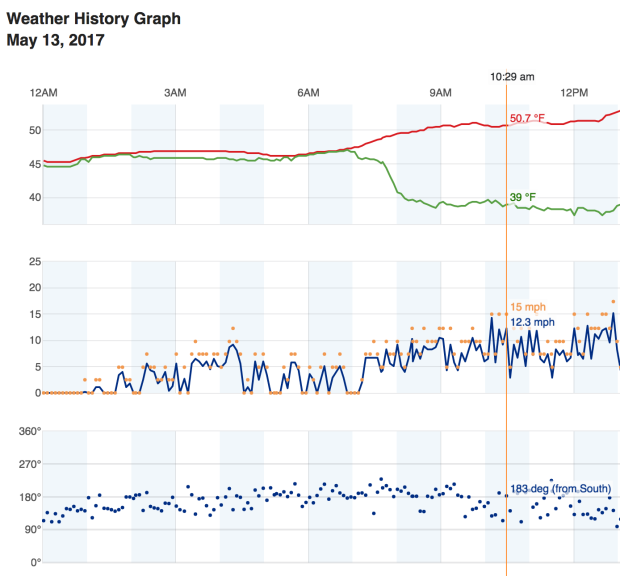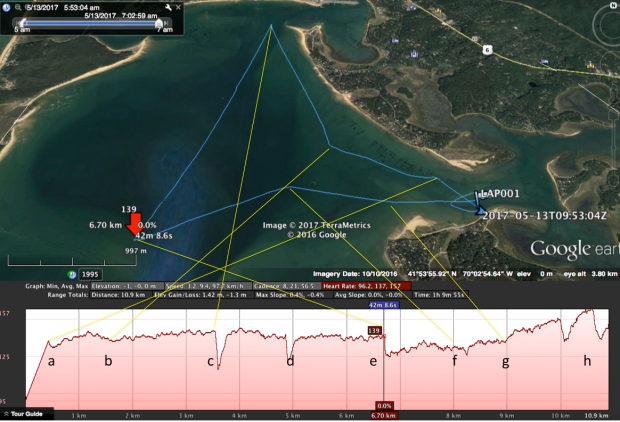Today was going to be my grand adventure. But it didn’t turn out that way.
I got to bed around 11, and I slept hard until almost 9am. So, I got a later start than I wanted to. I finally was loaded up and left the house around 9:30. While I loaded up, I realized that I had forgotten to print out my map. Damn. I guess I would do the best I could from memory. I drove over to a different beach which I thought would be better for launching near low tide. It was.
I got everything down to the beach and was about to put my boat down in the water when I noticed that I didn’t have my seat. Blast! I put my boat up high on the beach (the tide was coming in) and drove home to get my seat. About 10 minutes later I was back on the beach putting my boat in.
The partly cloudy and light easterly winds that were advertised did not seem to be in evidence. The sky was grey, and a moderate wind from the South was blowing. This beach faces north so the water was nice and flat off this beach. The wind was going to get worse. Here’s the weather data.

I finally launched just before 10am. I wanted to be home before noon, so I decided that I would limit my adventure to about 90 minutes.
Here was my original plan.

Here is what I actually did, superimposed on the plan.

Here is the course, from Google earth, with heart rate, which helps tell the story.

a. Launch from beach. Notice that the Speedcoach isn’t showing pace. Remember that speedcoach is set to use impeller, which this boat doesn’t have. Stop and change the setting of the speedcoach. Start rowing again. Take 10 strokes, notice that the speedcoach is not started. Start the speedcoach. Get going. Notice that the water is getting quite shallow. Decide to change course to take me a bit offshore.
b. Stay on the same course until I reach 1.5km. Then return to original course (330deg). The wind is building a bit now, and the waves are pushing around the stern. I’m surfing on some of the waves. This part of the row was good fun.
c. When I reach the breakwater at the mouth of Wellfleet inner harbor, I stop and turn. Now I really notice how much the wind has built. I made this turn at about 10:10. The wind was 12 mph sustained with gusts up to 15. The waves were starting to build. I started to push up into the headwind. I thought the course from my plan was 210 deg, it was actually 200.
d. Anyway, I was doing fine for a while, and then I hit a stretch with particularly nasty waves. I stopped to open up the bailer and started again. That’s the little dip in the HR. Looking at the chart, that place seems to be a bit shallower. I guess it would make sense that the waves would be nastier in the shallower spots. It’s hard to see the difference looking over your shoulder. Anyway, after opening the bailer and getting going again, I was doing ok. Until…..
e. If you look at the google earth image, you can see the color of the water change. On the chart, you can see that the bottom shoals here. The waves suddenly got really, really bad. I wished that I had the gopro mounted because I’d like to look at it after the fact. It felt like the waves were well over a foot tall, and my bow was plunging right into them. They would roll back over the deck and completely fill the cockpit. This happened 3 times in a row and I decided that it was stupid to keep going in this direction. I had no idea if the wind would build and I was barely able to make headway as it was. I decided to turn for home.
f. I steered due east, and tried to work my way through the beam seas. You can see that my HR was pretty low in this stretch because I couldn’t really take full strokes. I just picked my way through the waves and when I would get a really bad set of waves, I would just paddle through them, then try to accelerate during the smoother chunks. After a while, I could see that my easterly course was going to take me too far north, so I turned and rowed to SE for a while.
g. As I rowed into the lee of the island, the waves were blocked and the water flattened out very nicely. I started to row with longer strokes and it felt really wonderful. My HR was quite low today for the level of effort. This section was very enjoyable.
I noticed that the pace was quite fast for open water, and I realized that even though I had a little bit of headwind, I was rowing with the current. I got back to the beach with about 9000m on the speedcoach. I like the blog title “10K on the Bay”, so I did 500m more past the beach, turned and came back. I was having so much fun, I kept going.



It wasn’t the long row I intended, but it was useful practice.
A side note. I spent an hour trying to fix the leak in my boat. It turned out that there are a couple of cracks in the bulkhead between the seat deck and the bottom of the footwell. The rigger attaches to this bulkhead and the screws that hold it in place were frozen in place. The whole bulkhead looks like it is about to go. Ultimately, I will need to cut out the whole bulkhead and replace it (or more likely just sell the boat).
But since I wanted to fix the leak and I couldn’t get the rigger off, I decided to just work around it. I mixed up a batch of epoxy resin and cut a few strips of fiberglass and just reinforced the area where the cracks were.

This photo shows the rigger attachment to the seat deck bulkhead.
Here’s a close up of the ugly repair.

It is not pretty, but it seemed to work. After bashing into the waves, I only had about a cup of water drain out after I was finished.
Tomorrow: Marathon training session.
| M2 |
3 x 20′ / 2′ |
MP, 10KP, HMP |
90.0% |
(167) |
Paces:
- MP –> 180 to 195W
- HMP –> 195 to 210
- 10KP –> 210 to 225
























































